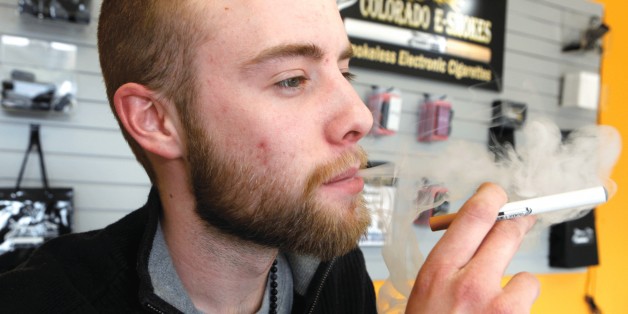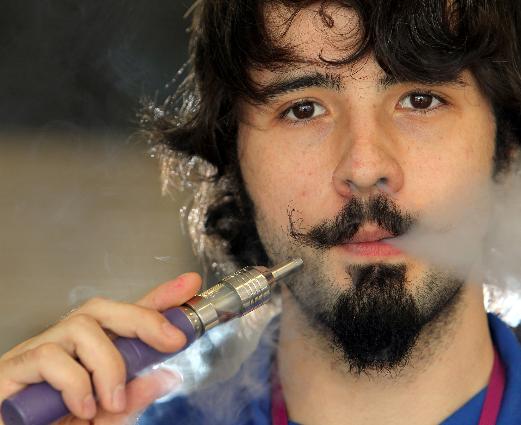E-Cigarette Ads Spark Lawmakers’ Concern for Youths
By Sophie Novack
An advertisement for Blu electronic cigarettes shows a glitzed-up, scantily clad Jenny McCarthy seated in a club, smoking—or “vaping”—a sleek black tube with a blue glow at the tip. “Blu satisfies me,” she says, as the camera pans out to show her chatting with an attractive male suitor who is also holding an e-cigarette. “I get to have a Blu without the guilt, because it’s only vapor, not tobacco.”
Blu is owned by Lorillard, maker of Newport and other tobacco cigarettes. Lorillard was one of nine recipients of a letter sent Thursday from 12 Democratic senators and representatives asking a series of questions about the marketing techniques of the e-cigarette companies. The letter raised concerns that e-cigarette companies are marketing their products to children and teens. Lorillard did not respond to a request for comment from National Journal Daily.
E-cigarettes—which resemble cigarettes but use battery power to vaporize a nicotine-derived solution that the user inhales—are not subject to the same regulations as traditional cigarettes, and their marketing is not limited by the restrictions placed on tobacco cigarettes in recent decades. E-cigarette companies can legally sell to minors, run television and radio ads, and distribute free samples.
“The marketing of e-cigarettes is re-glamorizing smoking and associating young, attractive celebrities with smoking,” Campaign for Tobacco-Free Kids President Matthew Myers told National Journal Daily. “Their participation in the last 12 to 24 months has used the exact same images and tactics that made [traditional] cigarettes so appealing to generations of Americans.”
E-cigarettes are available in a variety of different flavors, including cherry and cookies-and-cream milkshake, and they may be purchased online and in mall kiosks. Critics cite these marketing techniques, along with the use of celebrities such as McCarthy, as evidence of targeted advertising toward young people.
“[The ads] are virtual duplicates of the Virginia Slims woman from 40 years ago,” Myers said. “That imagery has been banned precisely because of its powerful impact on kids.”
The issue of this targeted advertising has received attention following a Centers for Disease Control and Prevention report released this month that showed dramatic increases in the use of e-cigarettes among middle- and high-school students. The percentage of young people who have used e-cigarettes doubled in both groups from 2011 to 2012, jumping from 1.4 percent to 2.7 percent among middle-school students, and 4.7 percent to 10 percent among high-school students.
While e-cigarettes are often presented as the less harmful alternative to traditional cigarettes, lawmakers worry that e-cigarettes could become a gateway to nicotine addiction and increased use of conventional tobacco products. “It would be a terrible public health outcome if children and young adults who do not smoke thought it was safe to begin using e-cigarettes because they do not believe that they pose a risk to their health,” Rep. Henry Waxman, D-Calif., ranking member of the House Energy and Commerce Committee and an author of the letter, wrote in an e-mail to National Journal Daily.
What has most worried some critics, however, is CDC’s finding that 80.5 percent of high-school students who use e-cigarettes also currently smoke conventional cigarettes. “This is a fly in the ointment of people saying e-cigarettes are good for harm reduction,” said Stanton Glantz, professor of medicine at the University of California (San Francisco) and director of the Center for Tobacco Control Research and Education. According to Glantz, so-called dual users generally smoke fewer traditional cigarettes each day, but smoking tobacco means they are still suffering the full cardio risk. E-cigarettes still contain some carcinogens—albeit less than tobacco—and deter quitting, Glantz says.
These findings increase concern that the advertising of e-cigarettes to young people will increase use of more-harmful tobacco products, and the marketing efforts are only growing.
According to the Kantar Media unit of WPP, the Blu e-cigarette brand spent $12.4 million on ads in major media for the first quarter of the year, compared with $992,000 in the same period a year ago, The New York Times reported. Annual sales of all e-cigarettes are expected to reach $1.7 billion by the end of the year.
Meanwhile, the Food and Drug Administration does not oversee the industry. The FDA’s Center for Tobacco Products has the authority to regulate only certain categories of “tobacco products.” The FDA “intends to propose a regulation that would extend the agency’s ‘tobacco product’ authorities—which currently only apply to cigarettes, cigarette tobacco, roll-your-own tobacco, and smokeless tobacco—to other categories,” an FDA spokesperson said.
The FDA can regulate e-cigarettes only if the manufacturers make a therapeutic claim—including use as a cessation device. According to the agency, none are currently approved for therapeutic purposes.
“Many of the most overt claims as a cessation device were made in earlier years, but they’ve gotten more sophisticated in recent years for fear of the FDA bringing regulatory action,” Myers said. Companies now target adults by making the less direct health claim that they are the safer alternative to cigarettes.
Lawmakers hope the letter and their calls for hearings will bring oversight not only to marketing of e-cigarettes, but to the industry more broadly. “Marketing e-cigarettes to children is problematic,” Waxman wrote in the e-mail. “But FDA also needs to undertake a broad assessment of e-cigarettes, the risks they pose, and the regulation of these products that is necessary to protect the public’s health.”
If the FDA were to institute broader regulations—something that has been discussed for a while now—then a simple claim that e-cigarettes are safer than cigarettes would require FDA approval.
This article appears in the Sep. 30, 2013, edition of National Journal Daily as E-Cigarette Ads Spark Lawmakers’ Concern for Youths.
http://www.nationaljournal.com/daily/e-cigarette-ads-spark-lawmakers-concern-for-youths-20130929



